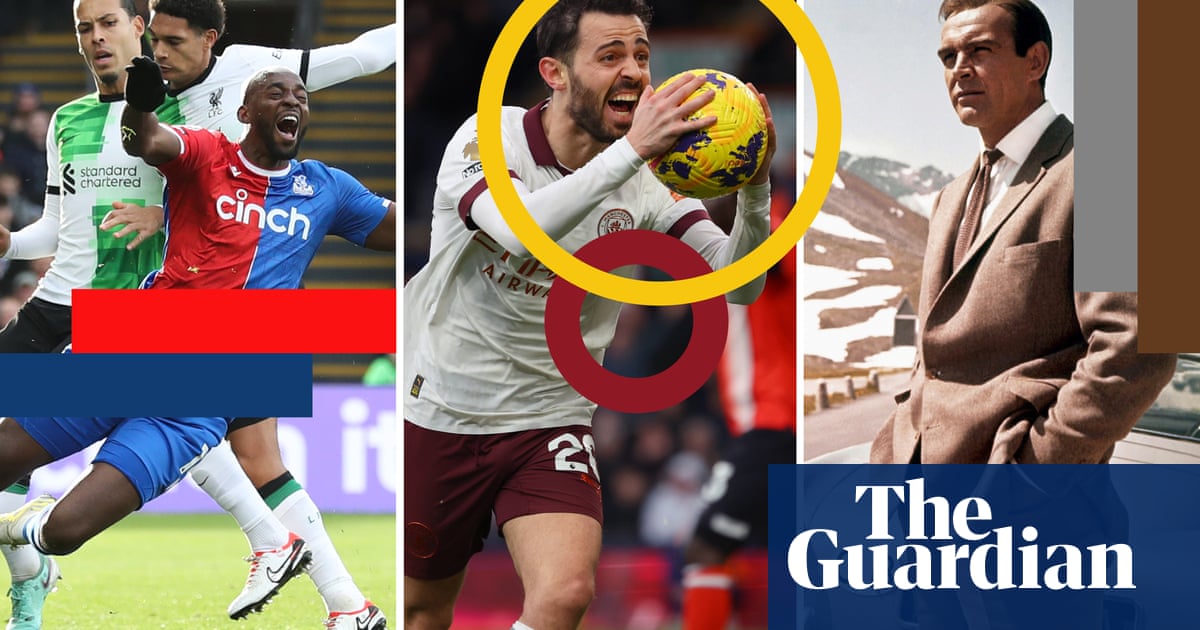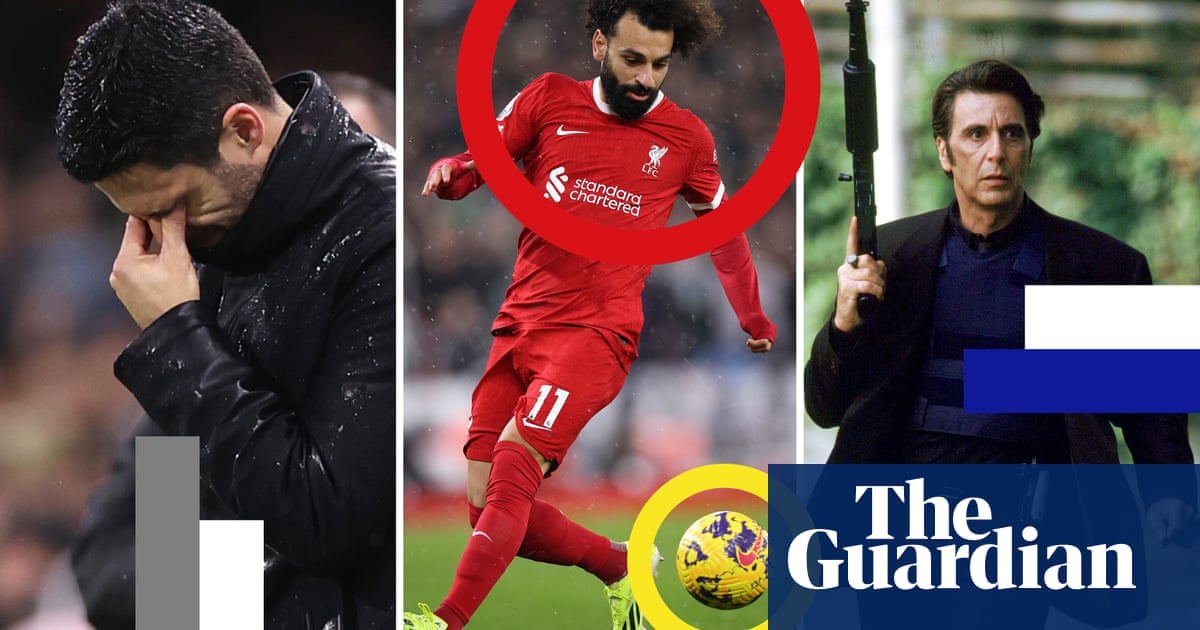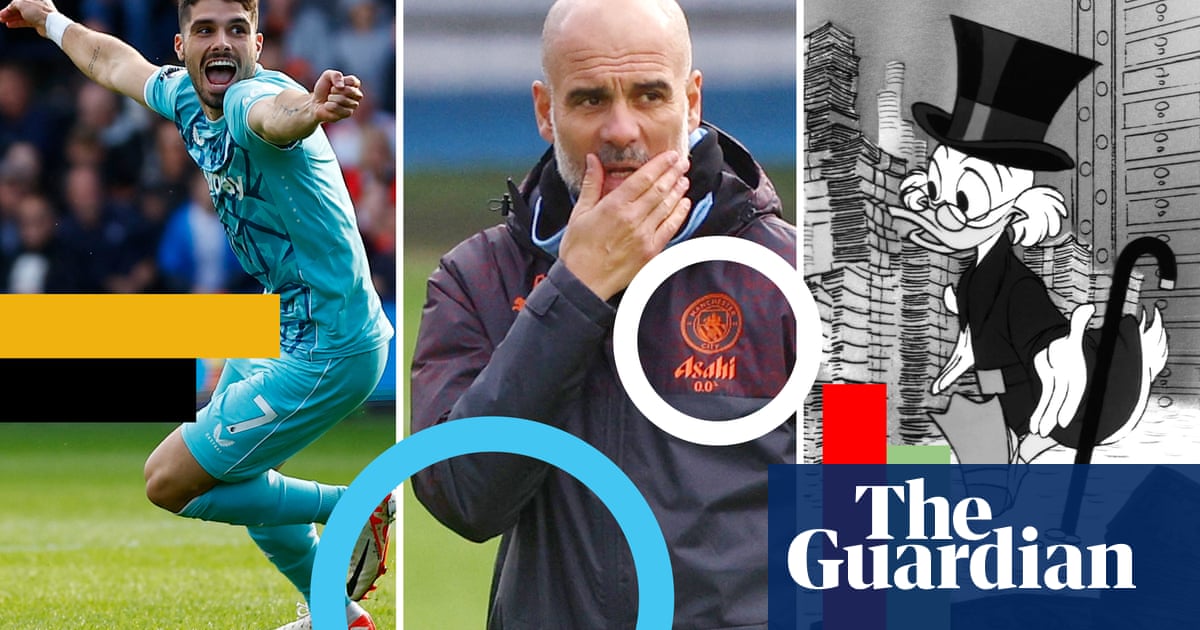
Player of the week
Arsenal are on a roll. Post winter break, they’ve reestablished their title credentials. Before the break, they had lost three games on the spin and scored just five goals in seven games. After the break, they have ripped off four straight wins and scored 16 times.
Their 6-0 demolition of West Ham on Sunday was Mikel Arteta’s side at their best. “We smelled blood and went for the kill,” Bukayo Saka said after the team’s win.
Saka has found his best form at a pivotal time. Against West Ham, he scored twice and won a penalty, taking his post-break total to four goals and four assists in four games. The same movement is there – the artful bursts, the subtle works – but now there’s more precision to his game, and an efficiency in the final-third.
West Ham had no answer for Saka’s positioning, placed just inside the left-sided fullback and centre-half. Opponent’s typically neuter Saka’s movement by trying to man-mark him out of the game or doubling up on the winger out wide. But by shuffling inside slightly and playing higher up the pitch, Saka has put opposing managers in a bind: do they track with a single defender – typically a holding midfielder – and vacate the middle of the pitch or ask the left side of the defence to figure it out as they go?
So far, there’s been no right answer. There has been a whole bunch of consternation about Arsenal needing a typical, classic striker upfront. But by playing with a more mobile, amorphous front three featuring Saka, Gabriel Martinelli and Kai Havertz, they’re able to take positions that put the opposition in a tactical bind. That has freed up Saka to do what he does best: create around the box.
Video of the week
The flip side of Arsenal’s performance was West Ham. What a disaster. David Moyes’s side were 4-0 down before half-time, at which point half of the London Stadium appeared to head for the nearest exit.
It was a limp and lifeless performance, just the kind that the fanbase has become increasingly accustomed to under Moyes.
And this is the strange paradox. Embracing the David Moyes Experience is about understanding you won’t play vibrant, fluid football, but that you’ll be defensively solid, out-scrap the opposition and dominate at set-pieces. When the three flow together, a team can grind out results, perhaps even drop a European trophy on the cabinet. But that’s vanished for large chunks of this year. West Ham have a more technical set of players these days, but they don’t play expansive football. And now the hard-charging, win-every-ball style that has defined Moyes’s run as a manager has evaporated, too.
Even more concerning is how vulnerable West Ham have been at set-pieces. Moyes’s side have conceded six goals from set-pieces this season, the sixth-fattest mark in the league. “The players have to take responsibility,” Moyes said after the game. “If you’re not tackling, turning you’re back, not winning headers etc. all those things are part of your job”.
Fair. But it’s also a manager absolving himself of responsibility for what has become a chronic issue. Arsenal represented the nadir. Mikel Arteta’s side are one of the league’s best from pre-planned routines. They’re innovative, crafting one-off gameplans to expose a team’s vulnerabilities. Arsenal have scored 16 goals from set-pieces this year, including two on Sunday, leaving them tied for second in the league. For a team hardly built out of domineering giants, it’s an impressive return. But more damning for Moyes is how ill-prepared his team looked – and how they failed to adjust when Arsenal’s plan became clear (bunching up everyone at the back post and then darting en masse to the near post as soon as the ball was about to be delivered). You could see West Ham’s indecision seeping through the screen. What are we supposed to do?
David Moyes is a fine Premier League manager. On balance – results-wise, at least – he’s worthy of a much-discussed contract extension. But there’s an aspirational side to this. West Ham’s football has been too turgid for too long. Fans didn’t flea the ground on Sunday because a title-chasing Arsenal were rampant in the first half. They escaped because it was all so predictable: the stale football; the lack of fight; the inability to adjust on the fly. Fans can soak up the embarrassment of a heavy defeat if there’s a hint that they’ll at least be entertained the following week. Under Moyes, that promise does not exist.
The Sandy Lyle award for best cameo
Manchester City were frustrated by Everton on Saturday. An hour through the game, Everton had one shot on goal to City’s zero. Enter: Kevin De Bruyne. City’s midfielder joined the party 57 minutes into the game and immediately went to work bending the game to his will. He capped his performance with a now trademark pass through to Erling Haaland for the second goal of the game in a 2-0 win. It was vintage De Bruyne. One touch to receiver the ball on the half-turn. One touch to get the ball out from under his feet. A quick glance to assess the situation. A perfectly weighted pass, on his apparent weaker foot, to spring Haaland open downfield.
The Premier League is spending an awful lot of its wattage these days assessing clubs for breaches Profit and Sustainability rules. But it’s time for the leagues grand council to get together to put a stop to this De Bruyne-off-the-bench stuff. Bringing De Bruyne off the bench is like when movies would snag Philip Seymour Hoffman for a cameo role. He’s overqualified. He can slot into any role. You don’t know exactly what he’s going to do, but you know he’s going to wind up stealing the movie.
Dropping Hoffman into a C-grade comedy immediately elevated it to an A+. Go on, spend the next eight minutes of your life in the most valuable way possible: Watching a Sandy Lyle supercut. When you’re finished there, do the only sensible thing: roll it back and watch again.
Hoffman was so talented it was unfair. De Bruyne is reaching a similar level. Premier League head honcho Richard Masters should invoke the Sandy Lyle Clause to stop City bringing De Bruyne off the bench. Seriously, guys, come on. Give the other teams a chance.
Even in a team full of stars, De Bruyne is City’s most irreplaceable player. Without De Bruyne, they’re great. With the Belgian, they’re damn near unstoppable. De Bruyne’s assist Erling Haaland helped City wrap the game up. But his impact was more manifest than that. With De Bruyne on the pitch, City cranked up the tempo. From part-plodding, part-laborious, they started to move the ball with more zest. “In the first half, our body language was not good, Pep Guardiola said post-game. “In the second half, the body language was a thousand times better.”
Body language, maybe. But it was the move to bring on the midfielder that changed things. For De Bruyne, any pass, from any angle, at all times, is available, passes that the likes of Matheus Nunes, Phil Foden or Julián Álvarez do not hit at the same clip. The rest of City’s chief creators excel in tight spaces. They pass and move, knocking it about in rhythmic procession, prodding and probing until they find an opening. De Bruyne brings some needed chaos to the order.
De Bruyne has averaged 3.09 key passes per 90 since his return from a hamstring injury, the only City player to cross the 2.50 threshold. But what’s more important is where De Bruyne has distributed from. De Bruyne has the highest average pass distance by far among City’s creators. Even Bernardo Silva, his own kind of creative genius, crafts openings with quick, short exchanges in the final third.
De Bruyne laps the field in passes into the opposition box this season, totting up 6.14 (!) per 90, more than three times as many as City’s next creator. But his key passes this season have all largely come from depth, sinking deeper to help stretch the field. Plenty of City’s players can make those passes, but few have the vision, movement and accuracy – with either foot – to make the connection to Haaland sing as much as De Bruyne.
Relegation subplot of the week
It’s cramped at the bottom of the table. Two points separate Everton in 19th and Nottingham Forest in 17th, pending Everton’s appeal for their 10-point deduction. After losing 3-1 to Chelsea on Monday, Crystal Palace are only five points clear of the drop zone.
When you ask any manager, player or supporter what they need to stay up, you’ll hear a chorus in return: goals. All teams near the bottom are chasing a goal-scorer who can put a run of games together to drag them to safety. But finding a proven finisher is not their main concern, it’s allowing cheap goals at the other end.
Scan the relegation race and something important jumps out: those at or near the bottom are not necessarily the sloppiest defensive teams in the league. Measuring by expected goals against – the value of chances conceded – Everton are sixth in the league and Palace are tenth. They’re conceding more goals than they should given the quality of chances they’ve coughed up.
Everton can point to their points deduction for why they’re fighting near the bottom. For the rest, they can look at their goalkeeper. The starkest example comes from Nottingham. Forest are seventh in the expected goals conceded charts (36), but have conceded the fourth-most actual, real-life goals.
It’s been a miserable season for USMNT goalkeeper Matt Turner. He’s conceded 28 goals in 17 league starts, has one of the weakest save percentages in the league and a series of wince-inducing advanced metrics: his post-shot xG (how much the keeper is responsible for a goal going in) ranks in the fifth percentile across all of Europe. Somehow, he was even shakier with the ball at his feet.
Turner was benched mid-season in favor of Odysseas Vlachodimo, who proved to be even more ineffective. The numbers paint an ugly portrait: Turner ranks 18th among 32 eligible Premier League goalkeepers this season in shot-stopping percentage; Vlachodimo ranks 27th, with an eye-watering 48% save percentage.
Forest spent the closing days of the transfer window traipsing around Europe to try to find any replacement, eventually landing on 31-year-old Matz Sels from Strasbourg on deadline day. Sels was immediately dropped into the starting lineup against Bournemouth after signing, but has hardly impressed. In the two matches he’s started, he’s conceded four goals and posted a 34% save percentage.
Sels might inspire more trust than Turner in general, whether it’s with the ball at his feet, organizing his backline or attacking crosses coming into the box. But he’s been a net-negative, in the tiniest of sample sizes, as a shot-stopper. Even Newcastle’s third goal in Forest’s 3-2 defeat on Saturday had a tinge of the should-have-done-better about it. It was a quality strike from Bruno Guimarães, and Sels was initially unsighted. But the keeper got a hand to it – and it this level, that can be the difference between staying up and going down.
Sure, the league’s bottom three are the final three teams in the expected goals conceded table, but Luton only have a fighting chance of staying up because they’ve let in nine fewer goals than the numbers suggest they should have. Thomas Kaminski has been one of the best keepers in Europe this season at saving efforts he has no business being near, which is a real sentence I just wrote.
If Forest are drawn into a three-way tussle with Luton and Everton as the season approaches its end, they won’t be wondering if they have enough fire-power upfront but about the disadvantage they have in net.












